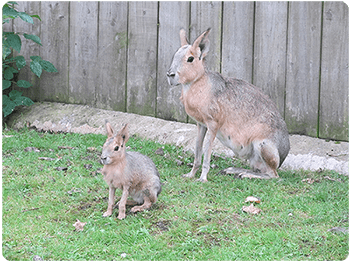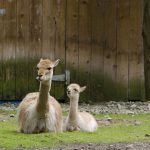It’s a mara baby boom!

Mara are classified into the same family as guinea pigs and capybaras, which are all native to South America. At Flamingo Land we have Patagonian mara, as opposed to Chacoan, and they can be visible from the treetop walkway in the zoo.
Mara look like oversized hares but their heads are more like a deer. Their backs are fairly grey in colour, with a white fringe towards their rear end, and they have golden brown fur on their front and around their face.
Despite being small animals, they are very fast runners due to the use of their strong legs. They are also good at digging out burrows to help keep their young hidden away.
The mara is a fairly timid animal which would run away from humans or predators. When it is not feeling threatened it would spend its day basking in the sun or eating. As it is a herbivore, it only eats vegetation, however it is not fussy about which type of plant because it has to compete with other larger herbivores for food. The mara population is declining due to the fact that they have to compete for their food, combined with habitat loss and hunting for their skins.
Most male mammals usually try to mate with several females to maximise the chances fathering multiple young and passing on their genes. However, when a mara is choosing a mating partner to mate with it needs to pick wisely as they remain with the same partner throughout their entire life. After mating, the female mara would be pregnant for 90 days and give birth in a burrow. She would leave the burrow during the day to feed but return when her young need to suckle. As there may be other young mara sharing the same burrow, the mother would call out and her young would respond and be taken aside to be fed away from the group. The male mara would keep a look out and make sure that other mothers do not return to feed their young at the same time, as too many adults around the burrow would draw the attention of predators.
We have had a mara baby boom at Flamingo Land this year! Several of our females have given birth so we have lots of new additions to our group of mara. Our youngest two were born in July which takes our total number of mara to well over 20 individuals.
Lindsay Taylor – Education Officer


